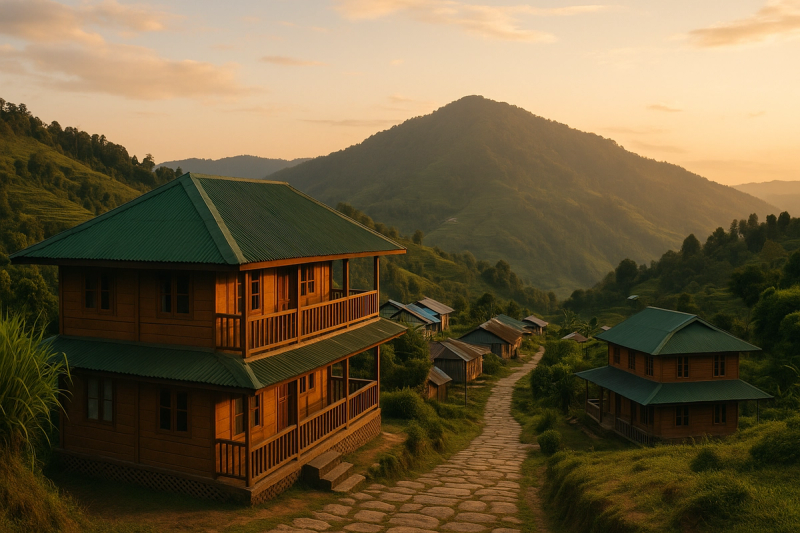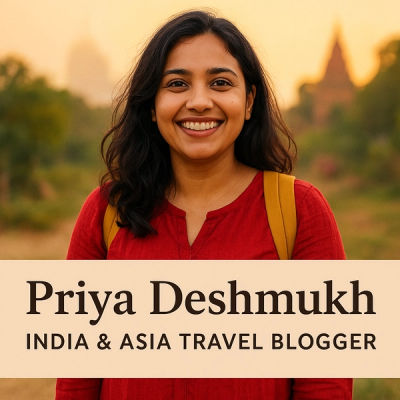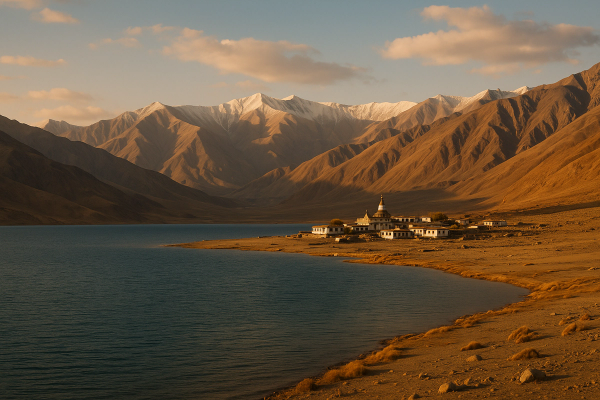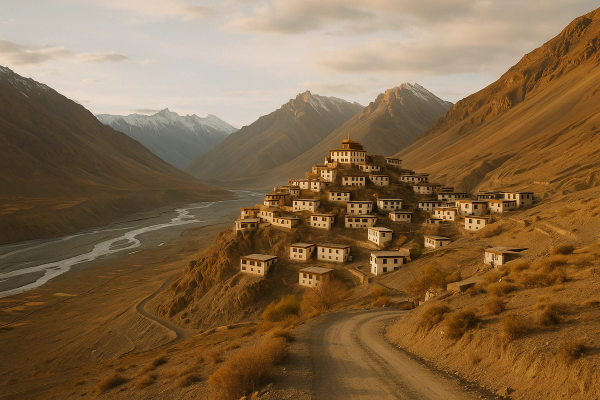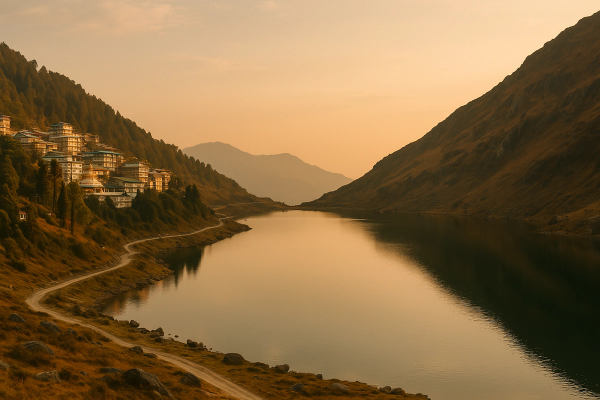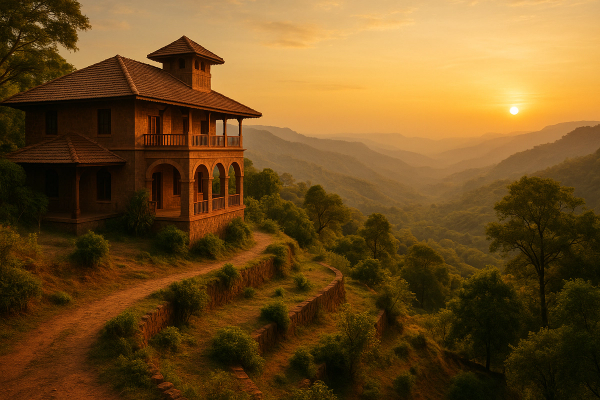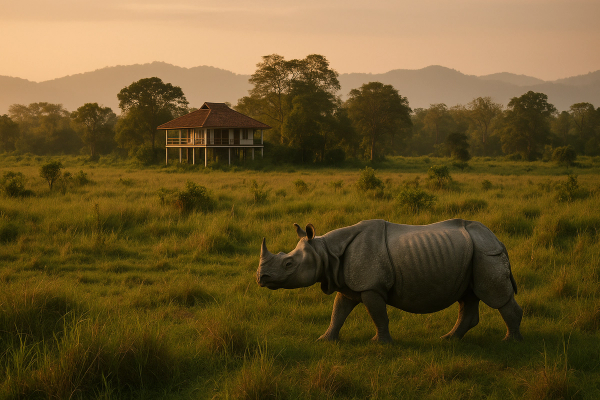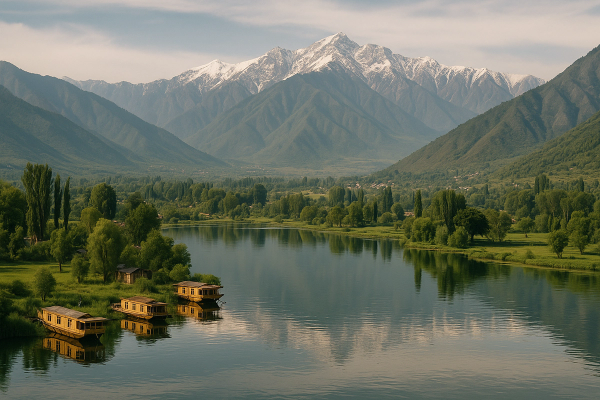Responsible Homestays & Village Tourism in Northeast India — a real trip, real people, zero filters#
I finally did it. Packed a small rucksack, jumped onto a shared Sumo from Guwahati bus stand, and started drifting across the Northeast for homestays and village life. No big resorts. No checklist-y sightseeing. Just staying where people actually live. Eating what they cook. You know, letting the hills and rivers slow everything down a bit. Northeast India is a mood. Mist, cardamom tea, bamboo and betel nut, churches on Sundays, and the gentle hum of rain on tin roofs. Trust me, it’s different when you go local. Not always easy. Sometimes messy. But that’s kinda the point. I wanted to travel responsibly, or at least try… spend money where it matters, not leave trash, listen more, talk less, learn, pay fair. Lots of small things. They add up.¶
So what do I mean by “responsible homestays” here?#
It’s simple-ish. Book family-run homes in the village. Hire local guides and buy direct from artisans. Eat the food they make, follow the rules they set, and don’t push your city habits onto their space. Pay the rates asked without endless bargaining. Avoid plastic. Ask before clicking photos. Don’t go gatecrashing into sacred spots. Easy in theory, but actually takes some discipline when you’re excited and everything looks pretty. I learned this the hard way in Khonoma, in Dzongu, in Majuli… yeah, me and my friend messed up once by casually walking into a restricted grove without a guide. Got a polite but firm correction. Felt bad, apologised, hired a village guide the next day, heard stories we would’ve otherwise missed. That’s responsible travel too — accepting you don’t know everything and being okay with local boundaries.¶
Meghalaya first… living root bridges and homestays that feel like home#
Everyone talks about Meghalaya’s living root bridges, but what stuck with me wasn’t just that double-decker legend in Nongriat. It was the homestays tucked into Laitkynsew and smaller hamlets where the Khasi folks are steering tourism their way. These days you’ll see village committees managing trails, ticket booths at entry points, and simple registers for visitors. The fee goes to upkeep and community funds, the path is cleaner, and you actually feel accountable. I stayed in a basic Khasi homestay near Laitkynsew — Rs 1200 for a room, another Rs 200 for dinner. Rice, dal, dried pork, bamboo shoot curry, and that special black tea they poured like it’s medicine for the soul. We did the steps down to the bridges with a local kid who was an official guide. He explained how they train the roots, which trees, and how long it takes. Sunday in many parts of Meghalaya is quiet — shops closed, church day — respect that. Also, plastic is a no-no on a lot of trails, and they do check bags sometimes. Good thing. Carry your trash back, no excuses.¶
Assam’s Majuli: sleeping by the river, masks and monasteries, and slow ferries#
Majuli felt like a dream where the Brahmaputra decides the tempo. I went via Jorhat to Nimatighat, then took the ferry. Water levels matter, timings change with the season, and the ride itself… watch the sky, it’s massive. Homestays on bamboo stilts cost roughly Rs 1000 to 1800 per night. Some include breakfast, many don’t, but you’ll always find a thali nearby. Don’t miss Samaguri satra where artisans carve masks for Raas. You can buy a small one for a few hundred bucks or just sit and chat. I got stuck in a late evening drizzle, and my host made us smoked fish while telling stories about floods and how the island shifts. Morning walks by the paddy fields are silent and wide. Best months here? October to March. Monsoon is dramatic but not the easiest for moving around. Oh, and UPI is usually fine, but carry cash because sometimes the networks decide to take a nap.¶
Nagaland: Khonoma’s green village and why the Hornbill buzz is not the whole story#
I planned Nagaland around the Hornbill Festival, which happens in early December at Kisama. It’s fun, yes. But Khonoma is where the real magic sits if you’re into conservation and community-run tourism. We needed an Inner Line Permit for Nagaland — Indians do — which we applied online and collected in Dimapur. Shared taxi to Kohima, then to Khonoma. Homestay rates here were around Rs 1500 to 2500. They will arrange local guides for forest walks, birding, and the terraced fields tour. Khonoma declared itself a conservation area years ago, which means hunting bans are a village-level decision. Respect that whole thing. Alcohol rules in Nagaland are a bit confusing, sales are restricted in many places, and enforcement can vary, so don’t make assumptions. Also Sunday is slower, many shops closed. My host made smoked pork bamboo stew that could fix a broken heart. We learned the local clan history in the evening sitting near a fire. If you go during Hornbill, book early because prices jump and rooms vanish.¶
Arunachal: Ziro’s quiet fields, and Tawang’s thin air and prayer flags#
Arunachal needs an ILP too. Ziro was calm, green, Apatani valley type of beautiful. We found a wooden homestay for Rs 1200 a night, meals extra but very reasonable. Ziro Music Festival usually happens around September and the valley gets busy, so book way in advance if you’re timing your trip with it. Non-festival times are perfect for loooong walks and chatting with elders about paddy cultivation and those fish channels. Tawang is a different ballgame — high altitude, 10,000 feet plus, cold winds. Don’t rush. Take two nights to acclimatise in Dirang or Bomdila. Permits can be checked on the way, roads can get tricky with snow and landslides, so always ask locals about current conditions. We paid Rs 1500 to 3000 for rooms in Dirang and Tawang depending on heating and meal options. Monastery visits are stunning, but also keep in mind not to click photos in prayer rooms, it’s usually not allowed. Even if someone else is doing it, just… don’t.¶
Sikkim’s Dzongu: Lepcha hospitality and rain that sings on tin roofs#
Dzongu is special — a Lepcha reserve where tourism is carefully managed. Many homestays here help arrange entry permissions for Indians, and make it easy. Foreigners have different rules, check ahead. We stayed by the river at a homestay in Hee-Gyathang. Rs 1500 per person including meals felt like a hug on a cold evening. Food is often local leafy greens, nettle soup, squash, millet-based roti, and yes, pork if you eat it. Evenings are for conversation and homemade chang. They’ll show you cardamom gardens and introduce you to stories around sacred mountains. Unlike Gangtok’s hustle, Dzongu asks you to slow down. Mobile networks are decent but not always. UPI worked until it didn’t — keep cash. If you go towards North Sikkim and places like Lachen or Lachung, permits are needed for Indians, coordinated by local tour operators, so plan a day extra for paperwork. And trust local driving advice, those roads are not for speed.¶
Manipur: Loktak Lake homestays and reality checks#
Loktak is unreal. Imagine floating phumdis and fishermen moving like shadows at dawn. I stayed near Moirang, in a small homestay for Rs 1200 with meals. Boat rides happen early morning or sunset. Just, please go with registered boat operators, and wear the life jacket even if your city brain says nah. Manipur has been through sensitive times since 2023, and travel advisories change. As of this year, most visitors are sticking to Imphal city, Loktak area, and well-known sites, avoiding certain hill districts. Inner Line Permit is needed for Indians to enter Manipur, and you should keep multiple copies. During the Sangai Festival in November, Imphal fills up with craft stalls, performances, food. It’s beautiful. But stay updated on safety and curfews, don’t move at night if locals advise against it. Be smart, be kind, and ask before photographing people. It really matters.¶
Mizoram & Tripura: quick hits that surprised me#
Mizoram’s Reiek is perfect for a village stay. Clean, quietly proud, with views that stretch forever. ILP needed for Indians, and homestays hover around Rs 1000 to 2000. Festivals like Chapchar Kut in spring are all colour and drums. Alcohol rules change from time to time in Mizoram, so read the latest before you land. In Tripura, Jampui Hills gives those orange orchard vibes in late autumn. Simple stays, Rs 800 to 1500, lots of conversations, lots of tea. If you get time, Debtamura rock carvings are mindblowing and lesser known. Connectivity is decent on highways but dips deeper in. Shared taxis are your friend when buses don’t line up. Oh, and English and Hindi will take you far, but a few local words and big smiles take you further.¶
Permits, transport, costs — the slightly boring but totally necessary stuff#
Permits first: ILP required for Indians in Arunachal, Nagaland, Mizoram, and Manipur. Sikkim needs permits for certain areas. Most can be done online or via counters in state capitals. Carry printouts. Keep soft copies too. Transport wise, you’ll be living in shared Sumos and small buses a lot. From Guwahati to Shillong, Shillong to Sohra, Sohra to Dawki — everything runs on shared cabs with fixed timings. Same story across Kohima, Dimapur, Aizawl, Imphal, Jorhat, Itanagar, Naharlagun, Gangtok. Trains hit Guwahati, Dimapur, New Jalpaiguri, Naharlagun. Flights connect most capitals, but not daily everywhere. Prices for homestays vary, think Rs 800 to 3500 per night depending on the village and season. Meals are often extra, but many places prefer a simple per person per day meal plan. UPI works in towns, chokes in valleys. Cash is king in the far-off hamlets. Keep small change. Weather can shut roads, so always buffer a day in your itinerary.¶
Best months, rain lessons, and why winter sunlight in the hills is a mood#
October to April is my sweet spot for most of the Northeast. Clear skies, festivals around the corner, and winter sun that turns every ridge gold. Meghalaya and Assam get lush in monsoon, but landslides and slippery trails make it rough. If you’re trekking to root bridges, try post-monsoon when the rivers are calmer, but still full. Arunachal high-altitude areas are best in late spring or autumn. Sikkim’s rhododendrons pop in April and May. December is a festival magnet — Hornbill in Nagaland, Raas in Majuli, and a bunch of harvest and thanksgiving events across. Summers are pretty, but don’t underrate the sun. Hydrate. Sunscreen. Cap. Always.¶
Food — the homestay plates that made me stare at the table with joy#
We all travel for food, no? Northeast homestays are where I ate the best. Apatani plate in Ziro with local greens and smoked meat that’s soft but earthy. Khasi meals with jadoh rice and spicy chutneys that hit the back of the throat in a good way. Naga kitchens where bamboo shoot changes everything. Sikkim’s nettle soup and ferns, sticky rice, and that side of pickled radish. Mizo bai, Tripura’s fish curries with herbs I couldn’t pronounce. Guest meals are simple but full of care, and hosts don’t like wasting food. Eat what you take, and give feedback respectfully if you don’t eat meat or are allergic. I had a hilarious moment in Dzongu where the aunty thought I looked hungry and doubled my rice even after I said no. That’s love. Bring digestive pills though. Village dinners happen early. Lights out by 9 is normal. Your city clock needs to adjust.¶
Little rules that go a long way — and keep villages happy to host us#
- Don’t litter, don’t leave cigarette butts on trails. Simple… but people still mess up.
- Ask before photos. Especially elders, craft workers, and anyone in sacred or private spaces.
- Pay for local guiding even if you think you can walk it yourself. That fee keeps the trail alive.
- Dress modestly. Some villages are conservative. Respect is not old fashioned, it’s basic.
- Sunday quiet is a thing in many places. Plan your shopping and travel with that in mind.
- If a spot is closed for monsoon or maintenance, don’t push. Nature needs rest too.
Travel slow. Pay fair. Eat real food. Leave nothing behind except good stories people can tell about you.
Safety updates and “be sensible” notes#
Roads are roads. In the Northeast, they can be gorgeous and moody and unpredictable. Landslides in monsoon and pre-monsoon squalls are common. Check fresh updates from the district administration pages or local WhatsApp groups hosts add you to. Night driving on hill roads isn’t heroic, it’s risky. Network can go off randomly. Share your route with your host if heading out early. As of late 2025, folks traveling to Manipur are advised to stick to well-known areas and keep an eye on advisories. In other states, usual safety applies — respect wildlife zones, don’t trample sacred spaces, don’t wander off marked trails. If you go trekking near root bridges or in Khonoma’s forests, go with a village guide. Altitude in Tawang can mess with you. If headache and nausea hit, slow down, hydrate, go low. Emergency numbers are best asked locally because response depends on where you are. Also, carry a basic first aid kit. It’s not overkill.¶
Costs right now, booking trends, and why WhatsApp might be your best friend#
Homestays range Rs 800 to 3500 per room per night. Meals add Rs 200 to 600 per person depending on what’s cooking. Guide fees vary, often Rs 300 to 1000 depending on trek length. Festival weeks push rates up. Many hosts prefer direct calls or WhatsApp over fancy booking platforms. Be patient. Sometimes messages get delayed because network is playing hide and seek. A 50 percent advance is normal. Don’t ghost them if your plan changes, it hurts small businesses. If you want curated responsible experiences, there are some regional networks and community tourism groups in Meghalaya, Sikkim, Nagaland that help match you with the right village stay. Not all are on big apps. Ask around, read reviews, then decide. Also, please don’t ask for deep discounts from homestays who are already pricing fairly. Paying the full amount keeps the system honest.¶
Lesser-known spots and things I’d absolutely repeat#
- Tea garden villages near Dibrugarh, Assam — not just photos, but staying in a worker-run home and listening to stories after sundown.
- Nongriat’s quieter neighbouring hamlets — same forest charm, fewer people, community tickets that actually fund trail repairs.
- Khonoma beyond the living room — birding walks with patient local guides who spot things you just… don’t.
- Dzongu short river walks — fog, wood bridges, and children giggling at city folks who slip in the mud. Me included.
- Reiek village markets in Mizoram — craftwork that is subtle and honestly priced.
- Jampui Hills in Tripura — oranges in late autumn, misty mornings, complete silence.
Random tips that saved me and might save you too#
Carry a light rain jacket even in winters. Pack a power bank and keep phone brightness low. Download offline maps for the whole region. Keep two ATM cards if possible. Carry cash, break it into small notes, and store in different pockets. Respect dogs in villages, most are chill, some are protective. Don’t pet without asking. Learn a few words — khub lei, thank you, works wonders in Meghalaya. And yeah, don’t be a noise machine. Nights are for listening to river sounds, crickets, and your own thoughts. You’ll be surprised what comes up when the city goes quiet inside your head.¶
Festivals to plan around without going wild on schedules#
Hornbill Festival, Nagaland in early December. Ziro Music Fest, Arunachal around September. Raas in Majuli around November. Chapchar Kut in Mizoram around March. Wangala in Meghalaya around November. Sangai in Manipur in November. Bihu in Assam — different ones across the year. If you’re chasing festivals, do it gently. Book early, expect crowds, and pick homestays in neighbouring villages if the main ones are packed. You’ll get quieter nights, same daytime buzz.¶
Why this trip changed the way I travel, or honestly, the way I look at time#
Village days don’t rush. There’s work, there’s rhythm, but there’s space to breathe. In the Northeast, I sat on porches and watched clouds for long, weird minutes that became hours. Talked to hosts about land, language, identity, and why tourism needs to listen. I realised responsible travel isn’t a checklist. It’s small choices. Carrying your trash. Hiring village guides. Paying fairly. Being okay with no WiFi. Choosing homestays over resorts even when it means a bucket bath and cold floors. I used to think I needed perfect plans and perfect stays. Now I chase imperfect corners where life is happening. If you go, go with a soft heart and curiosity that doesn’t push. The region is generous if you give it time.¶
If you want more travel stories and practical how-tos for the Northeast and beyond, I keep finding good stuff on AllBlogs.in. Not spamming, just saying it’s been useful when I’m planning my next slow trip.¶

